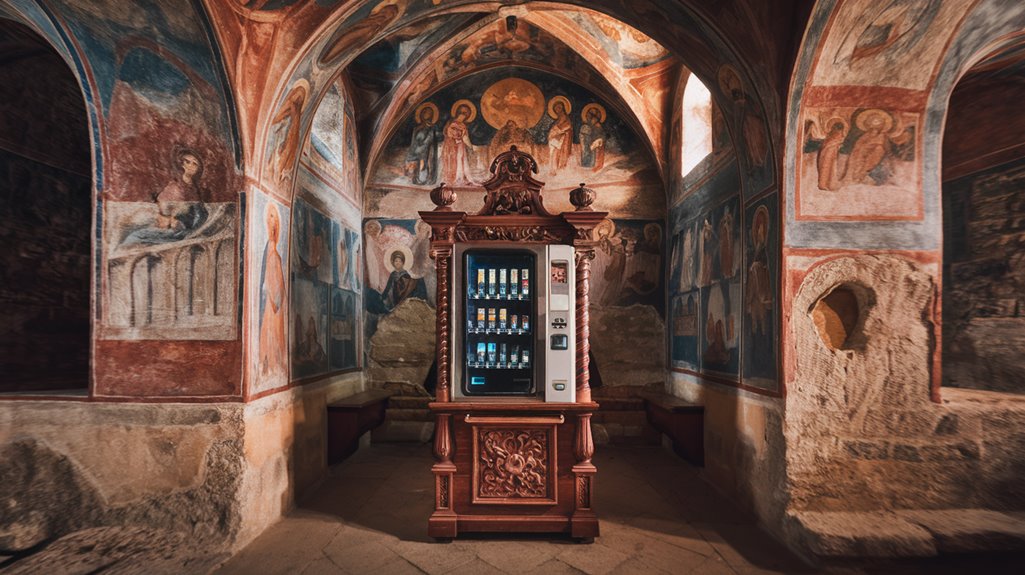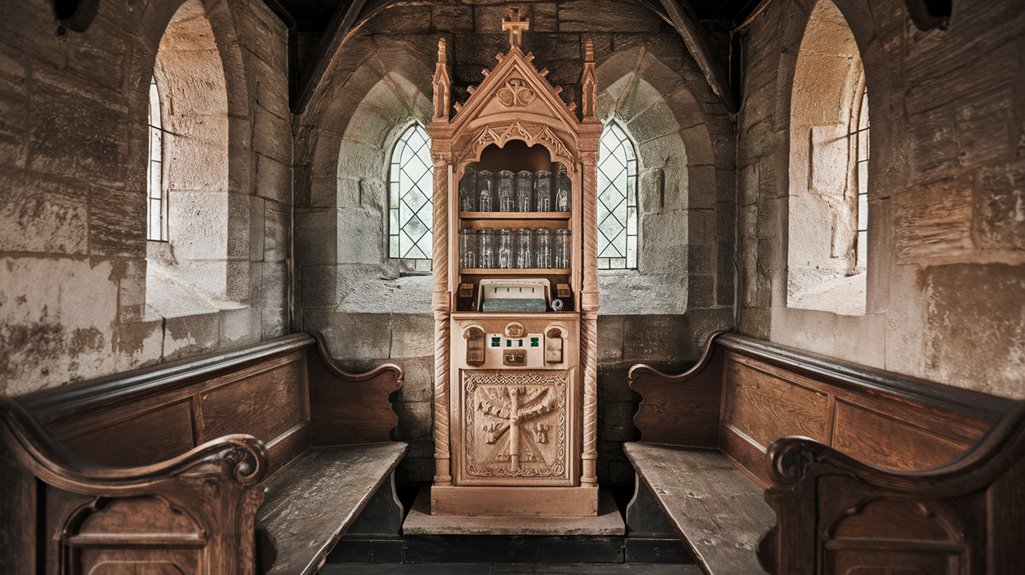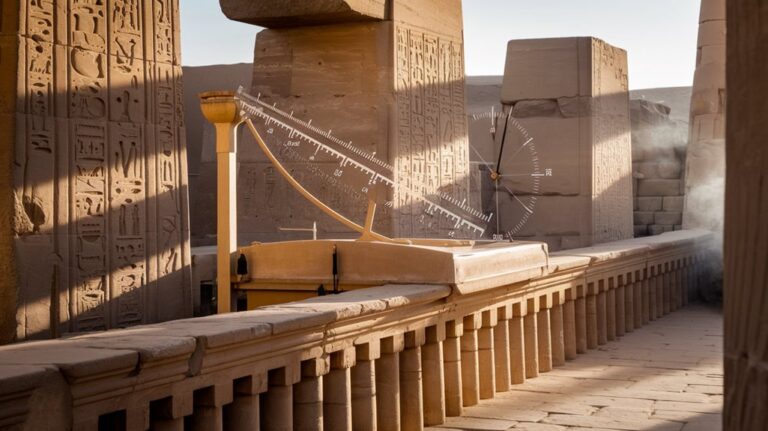The Earliest Known Vending Machine Dispensed Holy Water
You might not realize that automated retail began in ancient temples, where worshippers used coins to receive measured portions of holy water. When you consider today's vending machines dispensing snacks and beverages, it's fascinating to trace their origins back to first-century religious practices. Hero of Alexandria's innovative device didn't just serve a practical purpose; it marked humanity's first step toward self-service technology. The story behind this sacred machine reveals surprising connections between commerce, faith, and engineering.
The Ancient Origins of Automated Retail

While most people associate vending machines with snacks and sodas, their origins trace back to ancient Greece, where Hero of Alexandria invented the first automated dispenser in the first century CE.
This groundbreaking piece of ancient technology wasn't designed for convenience foods – instead, it served a sacred purpose in temples, dispensing measured amounts of holy water to worshippers.
You'll find it fascinating that this early example of retail evolution operated using a surprisingly effective coin mechanism.
When you'd insert a coin into the slot, it would trigger a lever that opened a valve, releasing the holy water.
Once the coin fell off the lever, the valve would close automatically, preventing excess use.
This ingenious system solved the practical problem of people taking more holy water than they paid for, establishing the foundation for modern automated retail.
Hero documented this innovative creation in his book Pneumatics, which provides detailed evidence of his mechanical expertise.
The brilliant inventor was also known for developing other revolutionary devices like the steam engine and syringe.
Hero of Alexandria's Ingenious Design
Three key components formed the heart of Hero's revolutionary design: a coin slot, a pivoting lever, and a simple string mechanism.
When you'd insert a coin, it would land on the lever, causing it to tilt. This motion pulled a string that lifted a plug from a container of holy water, demonstrating ancient engineering at its finest.
You'll appreciate how the system automatically regulated portions. Once the coin slipped off the lever's end, the plug would return to its position, stopping the flow. A counterweight sealed the valve, ensuring the water flow stopped completely.
This early example of automated spirituality solved a common temple problem: worshippers taking more holy water than they paid for. Hero's ingenious design, documented in his book "Pneumatics," wasn't just clever—it was centuries ahead of its time, laying the foundation for modern vending technology.
The Mechanics Behind Holy Water Dispensing
The mechanical brilliance of Hero's holy water dispenser lies in its elegant simplicity. When you insert a five-drachms coin into the slot, it lands on a carefully balanced metal lever. The coin mechanics work like a see-saw: the weight of your coin tilts the beam, which pulls a string attached to a plug, releasing the holy water. Early taverns in England would later adopt similar coin-operated mechanisms for their own vending needs.
The process doesn't end there. As the lever continues to tilt, your coin gradually slides off the pan. Once it drops, the beam returns to its original position, closing the valve and stopping the flow. Hero of Alexandria created this ingenious device in the first century to ensure fair distribution of holy water in temples.
This clever design guarantees you'll receive a precise amount of holy water for your coin – no more, no less. It's remarkably similar to how a modern toilet's flush mechanism works.
From Temple Innovation to Modern Commerce
As Hero's holy water dispenser faded into history, ingenious entrepreneurs discovered new ways to automate commerce through vending machines.
The World's Fair in Chicago marked the beginning of soda vending in 1893, revolutionizing beverage distribution.
You'll find that vending history took an interesting turn in 17th-century England, where taverns used coin-operated devices to dispense tobacco and snuff.
This evolution from ancient commerce to modern convenience sparked a revolution in automated retail. Operators today continue to shape the industry by implementing cashless payment systems to meet growing consumer preferences.
Sacred Beginnings of Self-Service Technology

Back in first-century Alexandria, ingenious Greek engineer Hero revolutionized temple offerings by creating history's first vending machine – a mechanical marvel that dispensed holy water to worshippers.
You'll find it fascinating how this early form of sacred commerce worked: drop a coin onto a pan, and the weight would trigger a lever system that opened a valve. Holy water would flow until the coin slid off, automatically closing the valve.
This simple yet effective mechanism marked the beginning of technological evolution in automated dispensing.
Hero's invention during the culturally rich Hellenistic period demonstrated how engineering could serve religious practices. The innovation helped prevent unfair depletion of the temples' sacred water resources.
The ingenious design dates back more than two thousand years ago, making it one of the oldest examples of mechanical automation.
While you wouldn't see another vending machine for nearly two millennia, this sacred innovation laid the groundwork for today's self-service technology that spans across industries and continents.
The Legacy of Hero's Invention
While Hero's holy water dispenser may seem primitive by today's standards, its revolutionary design sparked a legacy that stretches far beyond temple walls.
His machines were so advanced that some scholars consider him the greatest wonder-worker of ancient times.
You can trace modern vending machines directly back to Hero's engineering, which demonstrated remarkable sophistication through its coin-operated mechanism and hydraulic systems.
 the Museum of Alexandria, Hero had access to vast knowledge resources that aided his innovative designs.
the Museum of Alexandria, Hero had access to vast knowledge resources that aided his innovative designs.
His ancient hydraulics expertise wasn't limited to holy water dispensers – he also created automatic temple doors and experimented with steam power.
You'll find his influence in countless modern automated systems, though it took nearly two millennia before the first modern vending machines appeared in the U.S.
Today's self-service technology, from snack dispensers to electronic kiosks, builds upon Hero's foundational principles.
His documented works continue to provide valuable insights into the origins of automated commerce and mechanical innovation.










